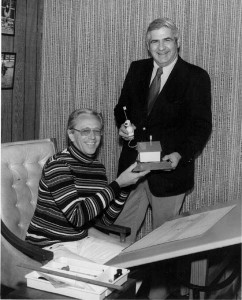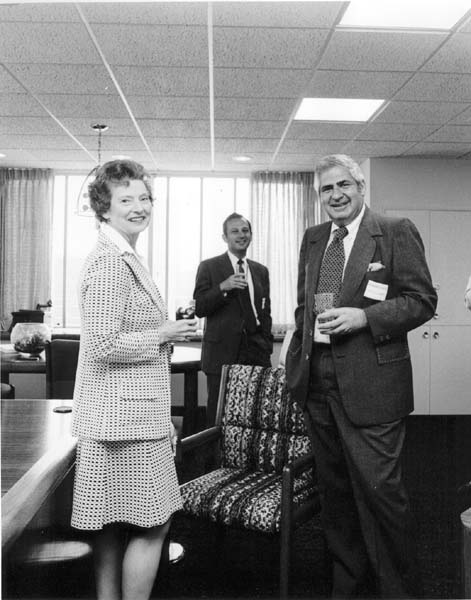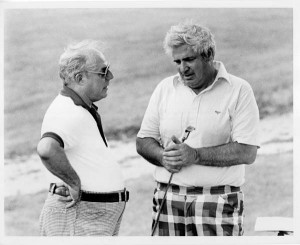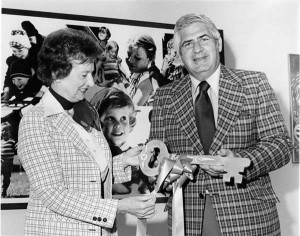Bernard Loomis
1970-1978 President of Kenner
1978-1981 Group Vice President of the General Mills Toy Group
1981-1984 President of MAD (Marketing and Design Group of General Mills)
Tell us a little bit about your background growing up, how you ultimately ended up involved in the toy business, and head of the most beloved toy company in history.
Born on the 4th of July (1923) in the Bronx, New York—a few blocks from where Yankee Stadium was and still is—-A not very affluent background that I wasn’t particularly aware of—because everyone in the neighborhood was in similar circumstances.
Stickball on the streets of the Bronx and basketball on the concrete courts of the schools and playgrounds were the games of my youth—Good enough to make the basketball team at one of the cities smaller high schools (Morris) wasn’t good enough to do more than that. College was at night at the New York University School of Commerce, day time was for working at one non descript job or another until 1942 when it was off to war including being in the wrong place at the wrong time five times in thirty months in the Southwest Pacific as a member of an Air Corps Combat Communication Team.
The toy memory of my youth foretold some imaginative creative capabilities. Lionel trains were beyond my economic reach but I had a full color Lionel catalog which gave me ownership of every item in it. Years later when Lionel Trains, like Kenner, were part of the General Mills Toy Group of which I was the CEO, I told this story at a Lionel Sales Meeting and soon after received my first set of Lionel trains.
After the war it was back to NYU at night and back to work which ultimately led to a job as sales manager of a builder’s hardware company—-with the subsequent discovery that my independent sales representatives were doing a lot better financially than I was, I decided to become a manufacturer’s representative and joined forces with a man named Norm Samilson who was a rep in the toy industry. Toy lines soon became our reason for being and Norm and I were having fun in the late fifties selling to the new discounters Korvettes. Kleins and Alexanders and I were also calling on an account in Washington DC called Toys ‘R Us.
From a financial point of view we were doing fine—but from a creative point of view-there wasn’t a great deal of satisfaction in the role—and so when a growing California toy company came east in 1960 looking to add a third person to their marketing management I got aboard the Mattel skyrocket and had the opportunity to be part of the group that created the modern toy industry. From the 20 million dollar sales range of 1959 Mattel product and promotion innovation led the way thru the 100 million dollar level and thru the two hundred million dollar level and by the late 60’s Mattel was four or five time larger than the second largest toy company which was either Marx or Ideal.
The Loomis family, now complete with two great young daughters and an even greater and still young wife and mother headed west for a new home in the beautiful hills of Palos Verdes and Mattel headquarters in Hawthorne, California.
I had ten great years out of eleven with title changes from Field Sales Promotion Manager to National Sales Manager and Vice President of Sales and Vice President of Merchandising and then in the late sixties became the Head of the Wheels and Wings Division and took Hot Wheels to Market. In 1970 Mattel growth and Wall Street expectations were bumping heads as managing earnings reared its ugly head and I was personally bumping heads with the powers that be. I was still very much with Mattel but was in purgatory as a “consultant” and was also pursuing a PHD in Marketing at UCLA.
When did you work for the Kenner toy company, and what were the different positions that you held?
Many people in the toy world became aware of my “in limbo” status and when Craig Nalen of General Mills, who was acquiring and running the General Mills Group, heard about my status he set about convincing me that I wanted to join General Mills to ultimately take over his own role. After a few months of telling him to go away, that I was not interested in joining his big corporate world, I warmed to his clearer idea that he wanted me to run Kenner. I would be the number one man in Cincinnati while he played corporate politics in the big glass palace in Minneapolis.
Kenner at this time was an interesting company that always seemed to be trying to be a more creative company than it was capable of. When I told the buyer at Sears, then the number one retailer of toys, that I was going to Kenner as President, he blithely told me that “we never buy a new Kenner toy in its first year.” Al Steiner who was the senior brother of the founding three certainly had a creative flair, and he had a particularly valuable asset in a creative Engineer Jeep Kuhn, but the execution capability of the company was a long way behind. One of my first important people additions, was to bring in Karl Wojahn from Mattel as Vice President of Product Integrity, with the authority to make quality control what it has to be.
Kenner lost money in 1969. Bob Kinney who was then Chief Financial Officer of General Mills and subsequently became Chairman and CEO wanted to close it down. I was unaware of this at the time.
From 1970 on I was President of Kenner until 1978 when I moved up to Group Vice President of the General Mills Group which included Kenner. I was there until approximately 1981 and then started a design and development company within General Mills called M.A.D. (Marketing and Design) for the Toy Group until approx 1984. M.A.D. (in partnership with American Greetings) developed and managed all aspects of Strawberry Shortcake and Care Bears.
In my fourteen years of association with Kenner and the General Mills Group, each and every year was significantly greater in sales and profits than its predecessor. By the late seventies, General Mills was clearly the world leader in Toys. Mattel contended they were the largest company doing business under one name. Kenner’s volume as Kenner was significantly limited by the fact that their products were being sold by sister companies under other names, and their own income was limited to royalties. Kenner was the engine that drove Palitoy and Denys Fisher in England along with companies in France, Belgium, Holland, Spain, Italy, Mexico, Canada Australia and New Zealand.
What are some of the different Kenner toy lines you personally worked on?

Mr. Loomis and Charles Schultz, the late, great creator of Snoopy, celebrating the very successful Snoopy Toothbrush.
From the Snoopy Tooth to the Care Bears no toy company ever had a record of new product development to equal Kenner from the 70’s thru the early 80’s. My Plaque in the Toy Industry Hall of Fame shows the Six Million Dollar Man, Star Wars, Baby Alive, Strawberry Shortcake and Care Bears from Kenner, as well as Hot Wheels from Mattel and the Quints from Tyco, but the Kenner hit list is a lot longer than that.
The Play Doh Line and especially the Fuzzy Pumper Barber Shop, Sit and Spin, The Snoopy Tooth Brush, SSP TTP and many other profitable toy lines were brought to market during my years at Kenner and if I’m going to take the credit for all of these I have to remind you that I was also the decision maker on Steve Scout and Duke the Wonder Dog.
The only committee which I personally headed during my Kenner years was the New Product Group which brought together all the creative elements in the company. Kenner did have an asset in place when I got there who proved most valuable to me throughout the years in providing an outstanding marketing and control execution capability. His name is Joe Mendelsohn and he followed me as President when I moved up to managing the Group.
The Star Wars story is of course a story unto itself and I’ve already told it elsewhere and have contributed to Lucas Films own telling of the story. (That interview can be seen here on Rebelscum.com)
The Strawberry Shortcake and Care Bears Stories are also deserving of much more time and attention—but not now—
The Mattel philosophy as I knew it and perhaps was or am the first to state it, was to create the most exciting product, to do the most original and motivating communication to the public about the product, AND TO DO EVERYTHING IN BETWEEN BETTER THAN ANY ONE ELSE, TOO. The goal, and what I was most key in extending and developing over the years was to do it for products where one purchase would lead to another, be it Barbie, Hot Wheels, Star Wars or Strawberry Shortcake.
When I got to Kenner in 1970 Kenner’s “do everything else capability” needed great attention. Mattel systems and my own Mattel attitude was an important starting point in making it happen.
You refer to Kenner as the “most beloved toy company in history.” Why?
I could understand my saying that or a few people whose careers where totally at Kenner. My goal was to make it the most exciting and the most profitable, and to make its toys the most wanted and most appealing, but “beloved?” Not an adjective I would readily apply. I wanted the people who worked there to love it to an appropriate degree and to get up each morning and look forward to going to work.
Kenner’s first big step into the licensing game is considered to be when they acquired the rights to the Six Million Dollar Man license. What all was involved in landing that account?
I first saw the show on the air—I thought it was “toyetic” as hell and I personally went out to Universal and made the deal. It changed the licensing business.
You were responsible for the creation of the Baby Alive doll, a doll that was loved by so many little girls. Tell us a little about the process you went through while creating the doll, and what your inspiration was for the doll.
Every Monday afternoon that I was in town, we held a new product meeting which I chaired and which people were encouraged to be as open and outlandish as they could be. Jeep Kuhn and his group presented a mock up of a doll that had “complete peristaltic action.” It would eat and you know what. Perhaps some one had a hope that it really could be a product, BUT IT WAS PRESENTED AS A JOKE. My response was “I think that’s very funny, I ALSO THINK WE CAN SELL A MILLION UNITS.” That was Baby Alive and we sold a lot more than one million. It was one of the two most lonesome decisions I ever made. The other one was the Star Wars Gift Certificate.
Did you work on any toy concepts that for some reason or another did not get produced?
On a shelf in my den where I am writing this, is a model of a soft body Charlie Chaplin doll which was never produced. In the years of saying yea or nay to toy concepts, I have said “no” more often than not, and I have said “yes” to more than one bomb. Steve Scout and Duke the Wonder Dog to name two, BUT THE ONLY CONCEPT I RECALL THAT I SAID NO TO THAT WENT ON TO BECOME A BIG HIT SOMEWHERE ELSE, WAS EVEL KNEVEL and I did it twice. Once at Mattel for Hot Wheels, and then again at Kenner when an independent inventor named Marvin Glass showed it to me as an add-on to SSP. Ideal did the Glass version successfully a year or two later.
While working on the toys at Kenner, did you ever dream that they would be as collectible as they are now? Does it surprise you now that the toys are so collectible?
Did I ever dream of collectibility? More than once, when we were introducing Star Wars, I called in our controller Gary Kleven and I said “Gary. Let’s put away one carton of each new toy and forget about it.” Some time later Gary came back to see me with an analysis showing how costly it would be, and we never did it. Probably not the best decision I ever made, but on the other hand what would forty eight pieces of every Star War figure ever made do to the collectible marketplace if they were suddenly discovered in pristine condition? Oh well that’s a yesterday, and my career has been built on today and tomorrow, and it’s been a good one.
What is your fondest memory of the time you spent at Kenner?
My fondest memory of my years at Kenner is a sum of all its parts, and it very much includes building a company’s reputation in its community. The Kenner Kids, a scholarship group we funded and supported at the University of Cincinnati Conservatory of Music, discovering that the production line workers in a company can and should be motivated by pride in the company along with the management employees, leading the General Mills Corporation in hiring and training minorities, being the first company in Cincinnati to do an urban wall-and lots of good stuff that can and should be part of running a company.
This interview was originally presented on KennerToys.com. Mr. Loomis passed away in 2006.
Did you previously work for the Kenner toy company?
We would love to hear your story!
Just click here to send us an email,
and you can help preserve the Kenner history.




My Original Darth Vader is a 12 inch doll from 1978 and other´s Darth Vader from the same year they do not come with the cómic book and the certificate of guarantee coupon I would like to know why. thanks
Great interview! Thank you so much!